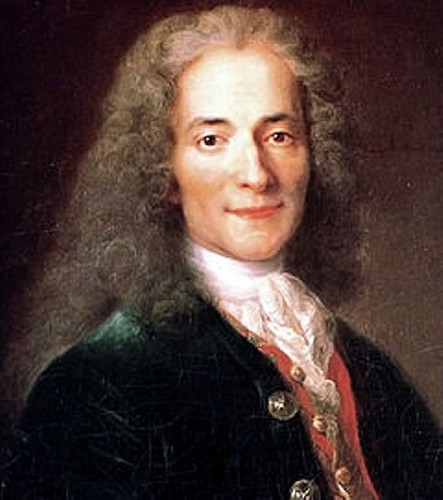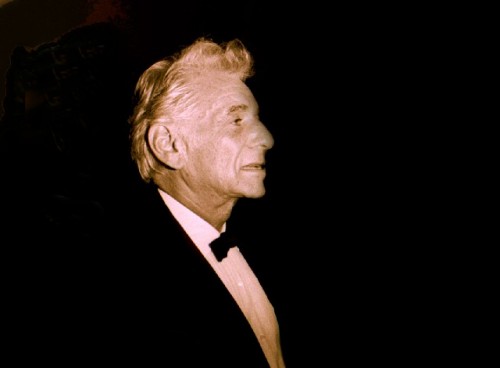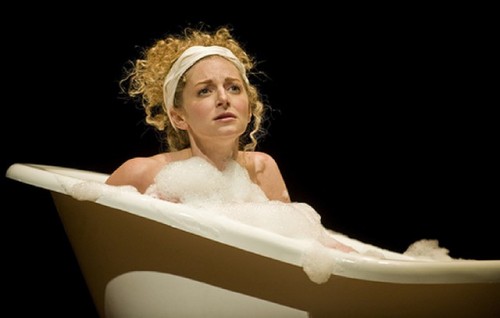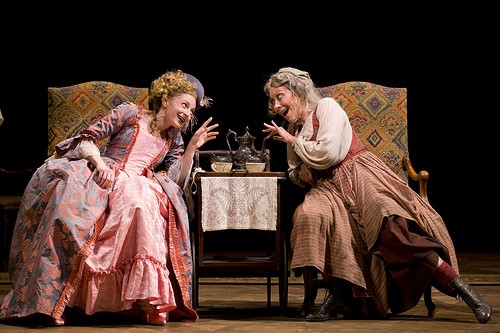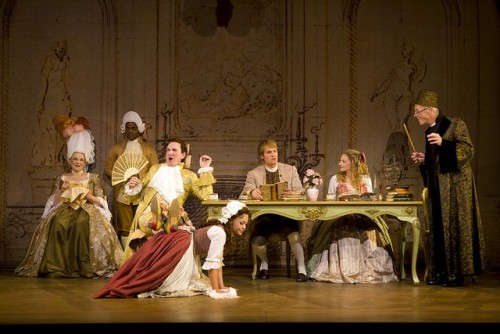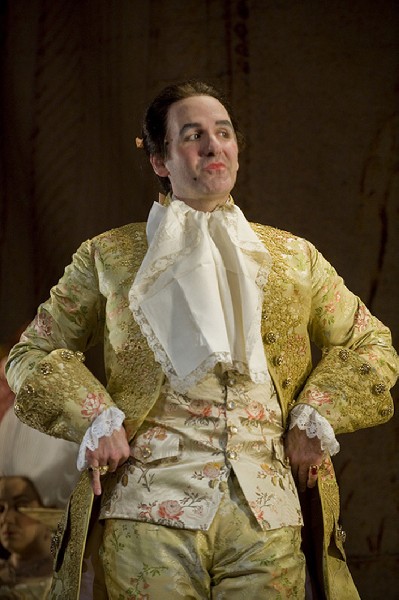Mary Zimmerman Directs Candide
Bernstein Musical at Boston's Huntington Theatre
By: Mary Zimmerman and Charles Giuliano - Sep 19, 2011
Mary Zimmerman is a member of the Lookingglass Theatre Company and is an Artistic Associate of the Goodman Theatre in Chicago. She received her BS, MA and PhD from Northwestern University, where she is currently a faculty member. She has earned national and international recognition in the form of numerous awards, including the prestigious John D. and Catherine T. MacArthur Fellowship (1998). She has won more than 20 Joseph Jefferson Awards for her creative work and received a 2002 Tony Award for Best Direction for Metamorphoses.
Zimmerman has directed several theatrical adaptations of literary works in addition to Metamorphoses, including Journey to the West, The Odyssey, Silk, The Arabian Nights (1994), and The Notebooks of Leonardo da Vinci (2003). In 2006 she directed a version of the Greek story of Jason and the Argonauts' search for the Golden Fleece, Argonautika, at the Lookinglass.
She is the director and co-librettist of the 2002 opera Galileo Galilei, music by Philip Glass, commissioned by the Goodman Theatre. In 2007, Zimmerman directed the first of a series of new productions for the Metropolitan Opera. She was engaged to stage Donizetti's Lucia di Lammermoor starring Natalie Dessay, which opened the company's 2007-2008 season. Lucia was revived in 2008-2009 with Diana Damrau and Anna Netrebko as Lucia. It was broadcast worldwide in the Met's Live in HD series with Netrebko and tenor Piotr Beczała.
In March, 2009 the Met premiered Zimmerman's production of Vincenzo Bellini's La Sonnambula (starring Dessay and Juan Diego Flórez). It was also presented in the Live in HD series. For the company's 2009-2010 season Zimmerman directed a new production of Gioachino Rossini's opera seria Armida.
Charles Giuliano You are with your dog and constant companion in Copley Square. Is Voltaire another constant companion?
Mary Zimmerman He has been for the past couple of years but soon will no longer be. Certainly I’ve been close to him for awhile.
CG If you accept his statement that "the pen is mightier than the sword" he was the most dangerous man in Europe during the 18th century.
MZ He was viewed as dangerous but it all comes down to the Lisbon Earthquake. And his response to it. He wrote a poem on the Lisbon Earthquake that bemoaned its random violence. The horror of it. He was chided for it by people of the day stating that you don’t understand God’s plan. We can’t possible know His plan and surely there was some reason for it. Voltaire thought this was so absurd that Candide was written in response to that. Some people claim that the Lisbon Earthquake is the beginning, the seed of modernism. By destroying the preexisting hierarchies. It started to crumble paradigms of thinking. It was All Saints Day and everyone were in churches and then they collapsed on them. So there they were praying to God when it happened.
CG What was the date of the Lisbon Earthquake.
MZ I want to say 1755. But I’m not positive. You should double check that for me. Candide is 1756 and then in 1759 he did a revised version.
(The 1755 Lisbon earthquake, also known as the Great Lisbon Earthquake, was a megathrust earthquake that took place on Saturday, 1 November 1755, at around 9:40 in the morning The earthquake was followed by fires and a tsunami, which caused near-total destruction of Lisbon in the Kingdom of Portugal, and adjoining areas. Seismologists today estimate the Lisbon earthquake had a magnitude in the range 8.5–9.0 on the moment magnitude scale with an epicenter in the Atlantic Ocean about 200 km (120 mi) west-southwest of Cape St. Vincent. Estimates place the death toll in Lisbon alone between 10,000 and 100,000 people, making it one of the deadliest earthquakes in history.)
CG Wasn’t there a philosopher who espoused the theory of Optimism?
MZ Yes indeed. But it’s confusing because there was more than one. And one of the guys was named Rousseau but it’s not the Rousseau that we think it is. Not the more famous Rousseau.
CG Voltaire was often arrested after his publications.
MZ Yes.
CG He wisely developed the habit of being out of France when his works were published. Often he would visit his friend Madame de Staël. (Anne Louise Germaine de Staël-Holstein 22 April 1766 – 14 July 1817. She held her salon in the Swiss village of Coppet at the Château de Coppet at her father's estate on Lake Geneva.)
MZ He often published under different names. Voltaire was reading chapters to his friends in salons throughout Europe.
CG One of those salons was that of Madame de Staël in Paris as well as Switzerland during times when she was banished for her activism. They seem to have been close. Do you know about that?
MZ I know who she is and that she had salons. When I do something I stick to the primary sources as much as possible which in this case is a novel. And to Bernstein’s music.
CG It often seems that Candide is the only work that most people read by Voltaire. He wrote many other works particularly volumes on French history. Did you read any of his other literature?
MZ I read his short stories and novellas. I read his correspondence. And a couple of biographies of him but I’m not retaining much. I believe in stories and I cling to the story. That was my focus.
CG Why was Bernstein attracted to Candide?
MZ It was Lillian Hellman (June 20, 1905 – June 30, 1984). She approached him and wanted him to do some music for her adaption. That expanded into it becoming a musical. They were both interested in it for its relentless exposition of hypocrisy. The abuse of power. In the 1950s with the black listing it was something they were quite attuned to.
(The operetta was first performed in 1956 (73 performances) with a libretto by Lillian Hellman. Since 1974 it has been generally performed with a book by Hugh Wheeler. The primary lyricist was the poet Richard Wilbur. Other contributors to the text were John Latouche, Dorothy Parker, Lillian Hellman, Stephen Sondheim, Leonard Bernstein, John Mauceri, and John Wells. Maurice Peress and Hershy Kay contributed orchestrations. It was unsuccessful at its premiere. Many lyricists worked on the show: first James Agee (whose work was ultimately not used). The lyrics to "I Am Easily Assimilated" were done by Leonard and Felicia Bernstein, and Hellman wrote the words to "Eldorado". Hershy Kay orchestrated all but the overture, which Bernstein did himself.)
CG Compared to Bernstein's West Side Story which is more accessible Candide is difficult for audiences which is perhaps why it is less frequently produced. This is even stated in the Huntington’s PR.
LZ Of course, because it’s critical of human beings. It’s critical of human nature and is unoptimistic. It takes the very cherished American notions of optimism and can-doism and challenges them. So definitely. Plus the fact that Candide is inconsistent in its structure. He would revise it. So it’s not a really unified piece stylistically. It’s not smooth. It has rough edges for sure.
CG The Huntington PR states “The rarely produced Candide.” Can you comment on why that is?
LZ It’s the musical about which the book has always been considered to be problematic. From the very beginning. Now I happen to think that all versions work in certain ways. On their own terms and the Hal Prince Chelsea Theatre Center version was a kind of watershed production in American theatre.
(“In 1973 Robert Kalfin of the Chelsea Theater Center approached [Harold Prince to direct a new production of Candide]. . . Prince was reluctant to accept because he had thought the original was "awfully heavy-going and cold," a mélange of disparate elements; as Sondheim said, "Lenny's score was pastiche, Lillian wrote a black comedy, Guthrie directed a wedding cake." When he re-read Voltaire's Candide Prince was impressed by its "irreverent, prankish spirit," a quality altogether absent from Guthrie's production, but felt that he could proceed only with a new libretto. Hellman refused to rewrite, and Prince lured Hugh Wheeler, who turned Voltaire's odyssey into a knockabout farce brimming with narrative improbabilities and sexual high-jinks. Never pausing to philosophize or to point a moral, Wheeler's lean libretto with its cynical pokes at mindless optimism is true to the general spirit of its source.” Foster Hirsch)
That production was incredibly influential on a lot of people. Lilian Hellman didn’t like it at all and my music director (Doug Peck) tells me it is actually illegal to perform the original Lillian Hellman version because she took her name off of it after the Hal Prince thing. She denied rights to it.
Since then there have been other attempts. There are at least five versions of Candide. I think that music with that novel is a challenge. It attracted me because it’s something I’ve spent my whole life doing. Adapting prickly, difficult old texts. It’s sort of my territory. So I was interested in it.
CG To clarify. You say there are five versions. Are they all for Bernstein’s music? Or are they also plays?
MZ The music shifts in them. Bernstein went on revising Candide until almost the day he died. He was writing songs for it thirty and forty years after it happened (Leonard Bernstein, August 25, 1918 – October 14, 1990 ). He was refining it. Changing lyrics. It’s a very fluid text. Because of that fluidity and openness that’s the only way I would have dared to throw my hat in the ring. The Bernstein estate was very open to that because they know that Lennie was never 100% satisfied with it. He kept working on it too. He was open to that so it has a kind of unique openness.
CG What is the challenge of focusing on the 18th century with its courtly manners, social and political context? It is certainly not readily familiar to the average audience.
MZ Why is that necessary? The theatre is not a museum. Clearly the musical idiom has exactly zero to do with 18th century music. So you’re already off the base of that. There are little parodies of arias. But the musical idiom is of its time and the time in which he (Bernstein) wrote. So I think it would be quite odd to do some historical recreation of that time. The novel itself is not realistic or naturalistic.
CG How do the characters represent their time and psyche? In what way might Cunegonda be viewed as an 18th century woman?
LZ What I said to Lauren (Molina) who plays her is, just as in the 19th century, women were seen as absolute children, over sexed, or crazy. The rap on women in that century is that they are voracious sexually. That they are not to be trusted. Which is an interesting difference or shift. Again, I’m coming to the text through the gigantically influential voice of the music. I did not do an adaptation of Candide on my own with no music. This is Bernstein’s musical.
CG In 18th century France the women had a dominant role. Through the salons they manipulated and influenced the men who ruled the nation. So I beg to differ in your assessment of them. We have just seen here The Game (at Barrington Stage Company) based on the 1872 French novel Les Liaisons Dangereuses by Choderlos de Laclos. It focuses on the unique power of women.
The letters of the women are essential as they create a lively portrait of courtly life. The women were literate and witty. They read Rousseau, Diderot and Voltaire. The philosophes, particularly Voltaire, were prized guests at the salons. Madame de Pompadour was a fascinating and manipulative individual. Through her influence on Louis XV she was a factor in bankrupting the monarchy, which resulted in raised taxes, which triggered the revolution. She also gave the king political advice and was a conduit for court appointments. As mistress to the king of France she was de facto one of the most powerful women in Europe.
LZ Perhaps this was true among the very wealthy women but most women were not very wealthy.
CG Then how do you see Cunagonda?
LZ I see her as she is characterized by Voltaire. She starts out young and innocent and full of ideas. Dr. Pangloss is teaching her. Then she is violently thrust into the real world. It is her own Lisbon Earthquake of abuse. Dominance by an invading army and it changes her and she becomes someone who just needs to survive in the world. Doing the best she can using the only thing that she has which is her body.
CG At the end of Candide he is told that Cunagonda has changed. That he may not like her as she is now older and ruined. By comparison he does not appear to change from his boyish innocence through the course of the play. In the final scene we see Cunagonda as a wretched hag.
LZ Well, that’s how it is in the novel. In the novel our mind’s eye pictures as needed. In a way in that moment when Candide sees Cunagonda he’s off camera in our mind in the novel. On stage they are all on camera.
CG What were some of the challenges of staging Candide. The use of sets was richly varied and the costumes were wonderful and enhanced the drama. You had a number of devices to covey all the changes of locale. Like the bird puppet elements. How involved were you in that invention of staging and design?
LZ Have you seen any of my other productions? Journey to the West here in Boston. The Odyssey, The Arabian Nights, Nautica, Jason and the Argonauts. It’s me and the design team. That is our way. We have been doing it together going on fifteen or twenty years. Because of the types of texts I adapt you have to be ingenious. Things happen in poems and novels which are not written for the theatre. If it is written for theatre the playwright generally thinks how are they going to be able to do this on stage. Novels and epic poems don’t have that concern. In fairy tales the impossible happens every two minutes. That’s what I love. That’s what my career has been about staging those texts which were primarily oral. Then found their way into some fixed form. For me Candide is a relatively contemporary text. In Metamorphoses people turn into birds. I’ve been doing that very quick shifting of scene and epic for quite awhile.
(Metamorphoses is adapted from Ovid’s poem, Metamorphoses. It premiered in 1996 as Six Myths at Northwestern University and later the Lookingglass Theatre Company in Chicago. The play opened off-Broadway in October 2001 at the Second Stage Theatre, and transferred to Broadway in February 2002 at the Circle in the Square Theatre. It earned her a Tony Award for Best Director.)
CG For Candide is that your design team? Do you always work with the same people?
MZ Many of my shows including La Sonnambula and Lucia di Lammermoor (for the Metropolitan Opera Company) set design and costume design were by the same persons. Except for my lighting designer we all belong to a company called Lookingglass Theatre Company in Chicago. But I also work in a lot of other places and they do as well. I met Dan (Ostling) when he was a graduate student and I was a professor. He’s my set designer and I don’t know how many shows we’ve done together. It’s not like we’re a company. But when I’m hired. The director is the first to be hired. Then I hire the set, costume, and lighting designers.
CG How does it work?
MZ I don’t start to write until I start rehearsals. I write between two and four in the morning or two and six in the morning. Bringing in the text every day. I can do that because this is an adaptation on a text that exists. I am trying to be as close to the material, as spontaneous to the material, as immediate to the material as possible.
But that puts enormous pressure on my design team. The set design has to go by the same calendar as if I were doing a Shakespeare play and not changing a word. That is to say months, or a year, or a year and a half, or two years out you start studying the text with your team. You talk about it constantly. You sometimes travel.
I traveled to Scotland with my team for Lucia. We traveled to Italy for the opera Galileo (co-librettist of the 2002 opera Galileo Galilei, music by Philip Glass.) That was the same team. It was a fantastic adventure. You get inspiration from what you see in paintings. Going to the place is always invaluable because what happens every day in a place is not photographed in books. What hardware looks like. That kind of thing. Not to say we are trying to be historically accurate but we derive inspiration. We see a dominant form repeated over and over or a texture on a wall. Or something goes by on the street and we feel that is absolutely perfect. In Galileo Galilei there is not a scene in that opera which is not taken directly from our trip to Italy.
So it’s a collaboration. I tend to pick every fabric with my costume designer (Mara Blumenfeld). We do that together. I’ve let go of some of that because it’s gotten too big. Every step of the way we’re together.
CG Please clarify for me to what extent is the text Voltaire's and to what extent Mary Zimmerman's?
MZ You know Candide so you know when it’s mine and when it’s his. Day by day I’m constructing it. Candide has a certain structure. There is an order of events that’s important. For instance fairy tales or the myths of Greece and Rome or even something as vast as Journey to the West which is a Chinese epic I’ve done. You would call almost structureless because they are collections of stories and fairy tales. In that case the hard part is that I’m trying to figure out the structure as I go along. Or I’ve done an adaptation of The Notebooks of Leonardo da Vinci. You’re constantly trying to figure out what to choose and what not to choose that makes a rhythm. What emotion carries an evening.
Something like The Odyssey or Candide already has a structure. It’s contained enough. There’s a plot where one thing follows another semi logically. Travel, for instance. Makes sense geographically. In that case the burden of structure is off of me. What I’m trying to prioritize is what’s theatrical and seems to tell the story. What is necessary. What appeals to me. What I feel I can stage. What’s good for the performers whom I have already cast. Does it fit the set we’ve already designed. It’s all of a piece.
None of what I am saying applies to the operas, obviously, they’re written. Or to when I direct a Shakespeare play.
CG We saw a preview and the show opens a week later. What will happen between then and now? What are you working on? What are you tweaking?
LZ Last week I was still cutting lines and rewriting lines here and there. Lighting cues have to be cleaned up. It’s still not quite right. Entrances and exits. Who is to close what door. But it’s at that level of detail. It’s no longer structural. This show is now 22 minutes shorter than it was in Chicago. I cut 12 minutes in D.C. and another ten here. I’ve cut in fact some of my own favorite things. They were ornamentations of the novel and things that were not necessary but pleased me tremendously. And some were very funny. But they weren’t necessary to pressing the plot along.
CG It’s still a long play. What is it two and a half hours?
LZ The first act is 1:19 and the second act is 1:09. There’s also an intermission which is supposed to be 15 minutes but always ends up being 20. And it starts five minutes late. That’s how the theatre is.
CG Candide really got around. How do you manage all of those locales?
LZ That’s the really fun part. In what stroke can we do Venice? The church which is out on the dock is painted on the back. Then some of those very common posts or moorings. Or the jungle which we sort of took from Rousseau. Wigs at the theatre. In the theatre you have to be very compact particularly when it is flying around like that. You have to be selective in what you pick and make those changes really really fast. I like to move quite rapidly.
If you saw Lucia it is usually done with the curtain coming down once or even twice within an act. But we used a system of reveals so we never had to do that. I love the seamless forward movement of the action.
CG This seems like an expensive production.
LZ It has an orchestra. That’s the expense. It has, for these days, a large cast and that’s expensive too. Expensive would have been roll on gigantic new set pieces for every one of those 18 locations. Instead, we would just bring on one small item. Or a backdrop.
CG I loved that large, wood paneled space and how it was used inventively for entrances and exits.
LZ That was taken from a print of one of Voltaire’s studies. How the molding was.
CG Visually it’s a sumptuous production. There is always something wonderfully distracting to look at.
LZ I don’t know if I would say distracting. You’re in the theatre to look at things.
CG When Cunagonda’s brother (Maximilian played by Erik Lochtefeld) makes his first entrance the costume is just hilarious.
LZ I remember being on the phone with Mara and I said he should be fancier than Cunagonda. More fancy than we could possibly imagine.
CG Those shoes.
LZ With red heels. They are historic and Mara did some research on them.
CG You have wonderful singers. We had just seen Lauren Molina in Ten Cents a Dance at the Williamstown Theatre Festival. For a small woman she sure can belt it.
LZ She’s a dynamo and she played musical instruments in Ten Cents a Dance.
CG Is this production going anywhere?
LZ It’s not slated to go anywhere. We all love it so much we hope it does but it all depends on its reception. It depends on what producers come and see it which depends on critical response. People don’t get on planes and fly cross country even with the thought of producing it. We broke a box office record in D.C. and were nominated for twelve Helen Hayes Awards and won seven of them. But I heard that the lead critic there didn’t care for it. That prevents producers from getting on a plane and coming to see it. Unfortunbately. That’s what happens.
This is our third production of Candide and I am very grateful for this chance. The orchestra here is fantastic. It’s a musical city. And for the opportunity I’ve had to improve the show. To cut off another ten minutes has been fantastic. It’s probably not the end of Candide.
CG What are your immediate plans?
LZ I go home and I teach. I’m a professor at Northwestern and I’ll be a week late when I get home. Then I go to the Oregon Shakespeare Festival. I’m doing an adaptation of a Chinese play The White Snake there this winter.
CG That was done in Boston.
LZ Yes there’s an opera version of it.
Mary Zimmerman Doesn't Read Her Reviews.

